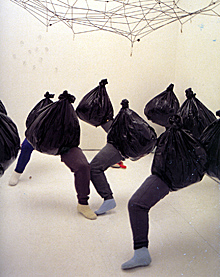7b
ひそやか系、スタジオ食堂、昭和40年会
Modest-type, Studio Shokudo, The Group 1965
【本文確定】
1999年1月、東京都現代美術館(略称MOT)は、年次展「MOTアニュアル」を開始しました。第1回展は「ひそやかなラディカリズム」と副題が付けられ、1990年代後半のある一定の傾向の作家が集められました。内藤礼、関口国雄、杉戸洋、高柳恵里、丸山直文、吉田哲也、中沢研、河田政樹、小沢剛の9名です*7b1。当時はほかにもこの語を冠したくなるような傾向の作家が少なくなかったため、「ひそやか系」なる呼称も生まれました。
1990年代初頭から活躍している内藤礼は壊れそうなほど繊細なオブジェを並べ、世俗から超越した特異な癒しの空間を作りました。高柳恵里は無造作に絞った雑巾がそのまま乾いて固まったものに造形性を認め、たわいもない日常にちょっとした概念操作を加えました。本展作家ではありませんが、スタジオ食堂の一員の須田悦弘は、実物と見まがう精巧な木彫の花や雑草を展示空間に溶け込ませ、鑑賞者は彫刻としてのマニエラに驚く一方で、インスタレーションとしてのあまりにひそやかな佇まいから、逆にラディカリズムを感じ取りました。
「スタジオ食堂」はグループ名ではなく、1994年に東京郊外にできた共同スタジオの名称で、1998年時点での参加アーティストは池田光宏、笠原出、小金沢健人、佐藤勲、須田悦弘、高橋雅也、田代悦行、中村哲也、中山ダイスケ、板東慶一、藤原隆洋、眞島竜男でした。どちらかというとハードエッジな作風の作家が多く、東京ポップの後続世代といった印象でした。2000年にスタジオは閉鎖されましたが、もともと彼らは個別に活動していました。
東京ポップのなかでは年少組だった小沢剛と会田誠の2名は、ともに昭和40年(西暦1965年)の生まれで、同年生まれの他の作家たちと1994年に「昭和40年会」を結成しました。結成時の記者会見に臨んだメンバーは会田誠、小沢剛、大岩オスカール[大岩オスカール幸男]、曽根裕、パルコキノシタ[パルコ木下]、松蔭浩之 (元・コンプレッソ・プラスティコ)、評論家の開発チエでしたが、曽根裕と開発チエが脱退、サウンドアーティストの有馬純寿と土佐正道 (元・明和電機) が加わり、全員40歳となった2005年には日本各地と韓国で「40x40プロジェクト」を敢行しました。彼らはもともと個別に活動する作家同士の仲良しグループにすぎませんでしたが、「昭和40年会」名義での活動ではイズムに縛られないそのゆるさをむしろ身上としていました*7b2。
昭和40年会より1歳若く、スタジオ食堂メンバーよりは年長の八谷和彦 (元・実験テレビカンパニー) は、「メガ日記」のプロジェクトやEメールソフト「ポストペット」の開発などメディア系に軸足を置き、その後は個人用の飛行装置を作るプロジェクトに邁進しました。土佐正道、土佐信道の兄弟ユニットとして出発した「明和電機」は、中小企業パロディとして人気を博しました。
前節で述べたように、時代支配的で強力なイズムが後退しました。それにともない、逆説的にひそやかなものに説得力が出たのが「ひそやか系」、イズムを後継しつつ場所を取っ掛かりとしたのがスタジオ食堂、ドグマに代わる生年をゆるくアイデンティティとしたのが昭和40年会でした。
【第一版のまま】In January 1999, a series exhibition "MOT Annual" was started at The Museum of Contemporary Art, Tokyo (MOT). Works having a certain tendency in the latter half of 1990 were gathered for its first exhibition, where the aim of a subtitle of the exhibition "Modest Radicalism" was clearly shown. Other than the following nine artists who took part in the exhibition, Naito Rei, Sekiguchi Kunio, Sugito Hiroshi, Takayanagi Eri, Maruyama Naofumi, Yoshida Tetsuya, Nakazawa Ken, Kawada Masaki, Ozawa Tsuyoshi, there were many artists whose works should also be entitled "Modest Radicalism," and the word "modest-type" was born.
*7b1
【第一版のまま】 Naito, who is active from the beginning of the 1990s, displayed delicately fragile objects side by side and made a peculiarly healing space standing aloof from the world. Takayanagi recognized formativeness in a crumpled floor cloth that was once casually wrung out and left as it is, and thus she added a subtly manipulated conception to everyday life space. Although he was not an artist for this exhibition, Suda Yoshihiro, a member of Studio Shokudo, integrated exquisitely wood-carved flowers and weeds into the display space, and just when audience noticed their modest existence, they felt some kind of radicalism.
【第一版のまま】"Studio Shokudo" is not a group name, but a common studio name for artists in the suburbs of Tokyo. Other than Suda, there were Nakamura Tetsuya, Fujiwara Takahiro, Kasahara Izuru, Sato Isao, Nakayama Daisuke, and Majima Tatsuo. Their style was rather a hard-edged one and gave an impression of the following generation of Tokyo Pop. The studio was closed in 2000, but they had been acting separately from the first.
【第一版のまま】Ozawa Tsuyoshi and Aida Makoto, young artsits in Tokyo Pop, were both born in 1965, that is Showa 40 in Japanese year number, and they founded The Group 1965 (Showa 40 Nen Kai) in 1994 with other artists who were born in the same year. The initial member were, other than Ozawa and Aida, Matsukage Hiroyuki (former Complesso Plastico), Oiwa Oscar Satio, Parco Kinoshita, Sone Yutaka, and Shin Myeong Eun, but after Sone and Shin had quit, Arima Sumihisa and Tosa Masamichi (former Maywa Denki) joined. In 2005 when everybody became 40 years old, they carried out "40x40 Project" in many parts of Japan and Korea. They were just members of an artist-friend-group acting separately from the start, and the looseness without being bound by any ism became their strong point.
*7b2
【第一版のまま】Hachiya Kazuhiko (former Experimental Television Company), who is one year younger than the members of The Group 1965 and older than the members of Studio Shokudo, put his pivoting foot on media-related ones like a project of "Mega Diary" and the development of email software "Postpet," and after that he pursued a project of making aviation equipment privately. "Maywa Denki," started as a unit of brothers Tosa Masamichi and Nobumichi, became popular as parody artists of minor enterprises.
【第一版のまま】In the former section, we surveyed work tendency of the age of diversity, and in this section artists' movement was surveyed. Owing to the absence of the strong ism, fragility had powers of persuasion, or, as the succession of the strong ism, their group identity was taken from some specific place or the year of birth.

